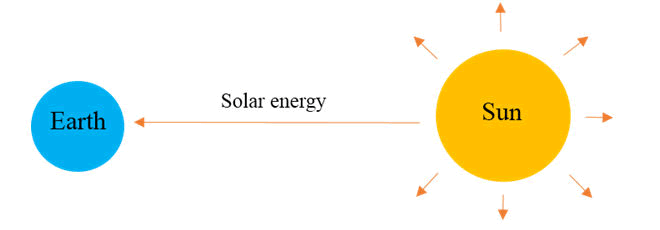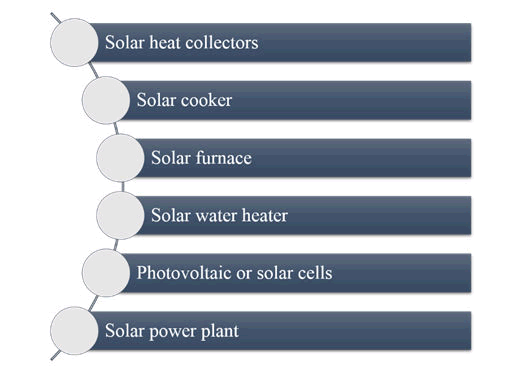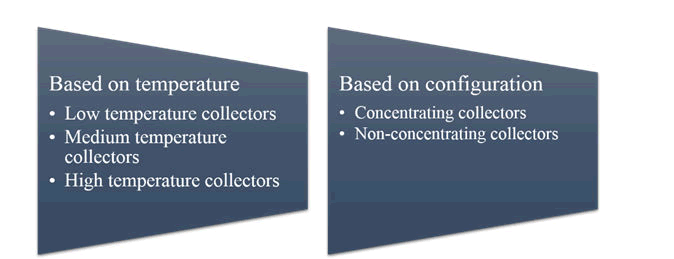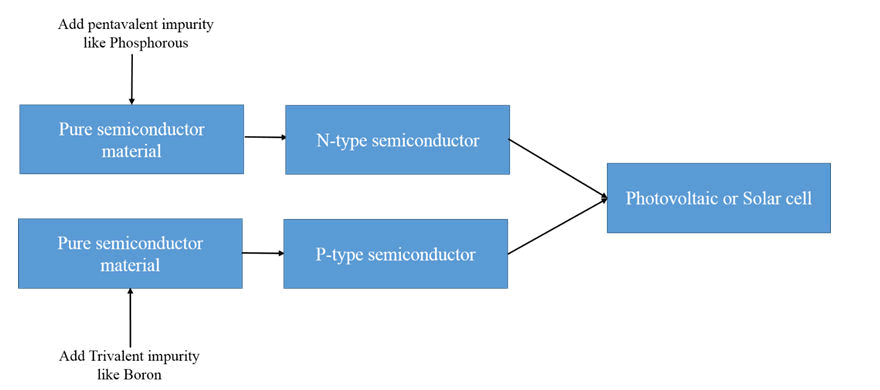Review Article, J Nucl Ene Sci Power Generat Technol Vol: 11 Issue: 4
An Overview of Solar Energy and Its Applications
Vikram Mor1*, Sonia Bhardwaj2 and Rishi Sikka3
1Department of Physics, SGT University, Gurugram, Haryana, India
2Department of Electrical and Electronic Engineering, RIMT University, Mandi Gobindgarh, Punjab,India
3Department of Electrical and Electronic Engineering, Sanskriti University, Mathura, Uttar Pradesh, India
*Corresponding Author: Vikram Mor, Department of Physics, SGT University, Gurugram, Haryana, India,E-mail: vikram_fps@sgtuniversity.org
Received date: 03 November, 2021, Manuscript No. JNPGT-21-46554;
Editor assigned date: 05 November, 2021, PreQC No. JNPGT-21-46554 (PQ);
Reviewed date: 19 November, 2021,QC No. JNPGT-21-46554;
Revised date: 03 January 2022, Manuscript No. JNPGT-21-46554 (R);
Published date: 23 March 2022, DOI: 10.4172/2325-9809.1000266
Citation: Vikram M, Sonia B, Rishi S (2022) An Overview of Solar Energy and Its Applications. J Nucl Ene Sci Power Generat Technol 11:4.
Abstract
Solar energy is a thermal energy that can be harnessed by utilizing the wide range of the advanced emerging technologies including photovoltaic as well as solar thermal energy etc. The conventional harnessing technologies are utilized nonrenewable energy resources that have huge adverse effect on the environment because it emits the various harmful as well as toxic gases. Solar energy can be considered one of the most promising and best alternatives of the non-renewable energy resources that can be used as a primary energy resource and for the production of the secondary energy resources such as electricity and steam. There are two major advantages are associated with the solar energy including availability and negligible air pollution generation. Electricity production is one of the major applications of the solar energy and widely employed across the world. This review paper highlighted an overview of the solar energy and its possible applications. In the future, solar energy can help to fulfil the energy requirement by growing population in the more efficient manner
Keywords: Electricity generation, Heat collectors, Renewable energy, Solar energy, Thermal energy
Introduction
Non-renewable energy resources (i.e, fossil fuels, nuclear energy and coal) are utilized from many decades in order to fulfil the demand of the energy. These energy resources are utilizing in two different ways:
As primary energy resources: For example, petrol and diesel are directly used in vehicles.
For the production of the secondary energy resources: For example, coal and petroleum products are used for the production of the electricity and steam [1]. Till now, we have already utilized 60% of the total storage of the non-renewable energy resources that is why the heavy consumption of the non-renewable energy resources can cause energy insecurity in the future. Apart from this challenge, the one of the major disadvantage of the non-renewable energy resource is emission of the harmful as well as toxic gases [2]. The emission of these gases to the environment leads to the environmental damage. The increasing level of the Nitrous Oxide (NOx), Carbon Dioxide (CO2), Carbon Monoxide (CO) and Sulphur Dioxide (SO2) causes climate change and global warming. In order to overcome such challenges, renewable energy resources have been exploring at greater scale [3]. The major advantage of the renewable energy resources is availability and no emission of the harmful gases and other toxic products. The most common renewable energy resources are: wind energy, solar energy, geothermal energy and hydropower etc. [4].
Among the all renewable energy resources, solar energy is considered as one of the most promising energy resource for consumption. The energy from the sun reaches to the earth in form of solar radiation that consist of infrared, radio waves, UV rays and gamma rays etc. [5]. The majority of the sun energy is in the heat form that this heat energy can be utilized for the different purposes. Solar energy can be used as a primary energy resource as well as for the production of the secondary energy resources such as electrical energy and steam. Solar energy based power plants are very useful for the rural as well as other isolated places because it reduces the burden of transmission and distribution lines [6]. Electricity generation is one of the most promising application that can used for the fulfilling the demand of the electricity by growing population. Currently, developed as well as developing countries established various solar power plants so that electricity can be generated in the country in green manner. Apart from various advantages there are some challenges and issues are also associated with the solar power based electricity generation. Some of the most common challenges are weather dependency, low efficiency and high initial establishment cost. In order to take this technology to the level, tackling of these challenges is must [7].
This review paper discussed about the solar energy and its associated aspects such as materials, applications and future prospects. This review paper will also discuss about the other renewable energy resources and will compare and explain how the solar energy is better as compared to the other renewable energy resources. The detailed overview of the solar will help to the researchers to understand the fundamentals of the solar energy.
Literature Review
Renewable energy resources
Renewable energy resources are referred to the sustainable and clean energy resources which are available in the nature in unlimited quantity. These energy resources will never run off in terms of the quantity. From last few decades, these energy resources gained significant amount of attention of many researchers because these energy resources are considered as futuristic energy resources [8]. The main advantages of these energy resources are availability and no emission of harmful gases. The major renewable energy resources are listed in the Table 1.
| Renewable energy resource | Description |
|---|---|
| Wind energy | Wind energy refers to the flow of the wind. It can be used for the production of the electricity. For electricity generation, wind turbines are utilized. It consists of the blades and generator. When wind flows and crosses through the blades, subsequently it rotates the generator in order to generate the electricity. |
| Geothermal energy | Geothermal energy refers to the earth’s energy. Since the temperature of the inner core of the earth is very high. When an appropriate liquid injected to earth then a steam is generated due to the evaporation of the liquid because of high temperature of the core. This steam subsequently transfers to the turbines. The pressure of the steam rotates the turbine and produce the electricity. |
| Solar energy | Solar energy is also comes in the renewable energy resource category. The sun radiated the heat due to the fusion reaction, some portion of the heat reaches to the earth. The reached heat energy on the earth utilized in many ways such as for cooking, water heating and electricity production. |
| Ocean energy | Oceans energy refers to the up and down movement of the tides. The rise and falls associated with the tides are greatly used for the production of the electricity. The major disadvantage of the tidal energy is that it is depending upon the weather conditions. |
Table 1: List of the renewable energy resources and their detailed description.
Solar energy
Solar energy is a kind of thermal energy that is generated by the sun. The major cause of this thermal energy is fusion reaction that occurs at the surface of the sun (as shown in the Figure 1). The utilization of the solar energy increases from last two decades due to the various disadvantages associated with the non-renewable energy resources. The major drawbacks of the non-renewable energy resources are high level emission of the harmful gases to the environment including SO2, NOx and CO etc. [9]. These gases increase the level or air pollution due to which various problems has been arisen including climate change and global warming. In order to overcome such challenges, renewable energy has been considered one of the most promising alternatives over the non-renewable energy resources. Solar energy is a type of renewable energy that will never run off in terms of quantity.
Solar energy generated by the Sun is spread in all direction equally and like earth, other planets also receive the solar energy of the Sun but the intensity is different. The intensity of the solar energy depending upon the distance between sun and the planet as well as atmospheric condition of the planet. Each planet has different layers of the gases and particles due to which the intensity of the sun gets affected. The received solar energy on the earth is very low in terms of the power density about 0 to 1.2 kW/m2. By giving an importance to the solar energy, in recent years’ various plants has been established in different countries in order to generate the electricity at larger scale [10]. Solar energy can be utilized in two different ways:
As a primary energy resource: primary energy resource means; it can be utilized directly for different purposes. Solar energy can be directly used for the cooking and water heating etc.
For the production of the secondary energy resource: secondary energy resource refers to the energy resources which produced from the primary energy resources or energy resources which convert to another energy resources from the primary energy resources. Some of the most common secondary energy resources are electricity and steam etc. One of the best applications of the solar energy is electricity generation that can be considered one of the most promising applications of the solar energy. Solar energy based electricity generation is very useful for the isolated as well as rural areas. It helps to produce the electricity locally that leads to the reduction in transmission as well as distribution system for the electricity. It also helps to develop local infrastructures.
Applications of solar energy
Renewable energy resources have many applications and can be utilized as a primary energy resource as well as can be used for the production of the secondary energy resources through the conversion of itself to the energy resources [11]. Like other renewable energy resources, solar energy resources also have wide area of applications and can be used according to the need of the energy [12]. Some of the most common application of the solar energy is shown in the Figure 2.
Solar heat collectors
Solar heat collectors receive and collect the thermal energy that is received from the sun. The collect thermal energy can be used for the different purposes [13]. Solar heat collectors can be classification in the two groups (as shown in the Figure 3):
- Based on the temperature
- Based on the configuration
Result and Discussion
Each class of the collectors has its own advantages and can be utilized depending upon the application. Some of them are inexpensive and easy to maintain and some of them are expensive as well as require high maintenance but offers high efficiency [14]. According to the need, best solar heat collectors can be choosing from the wide range of the solar heat collectors. The detail of each class of the solar heat collectors is discussed in the Table 2.
| Type of solar heat collectors | Description |
|---|---|
| Based on temperature | Low temperature collector: These type of the solar collectors is generally utilizing for the low heating applications such as heating of the swimming pools.Medium temperature collector: Medium temperature collectors are also belonging to the flat plat collector’s category that can be used for the heating of the air as well as water for the commercial as well as residential purpose.High temperature collector: High temperature collectors are used to collects the sunlight in order to collect the high temperature. The high temperature collectors are generally belongs to the concentrating collectors and mostly used for the electricity generation. |
| Based on configuration | Non-concentrating collectorsFlat Plat Collector (FPC): Flat plat collectors are non-concentrating in nature in which the dimension of the collector plat is equal to the absorber plat that leads to the unit concentration ratio. The main advantage of the FPC is low maintenance and the major drawbacks of the FPC are no sun tracking and low temperature. The basic components of the FPC are insulated box, transparent cover, absorber plat and tubes.Concentrating collectors: In these types of the collectors, there is an optical system is used in order to gain the high temperature. These optical systems are coming in the form of reflectors or refractors.FPC with reflectors: In this type of the collectors, a mirror is equipped to the FPC for increasing the heat collection through the concentration of the more radiation on the FPC absorber. As compared to the FPC, the temperature of the fluid in the FPC with reflector is 30?C more.Parabolic dish collectors: These type of solar heat collectors equipped with mirror like reflectors and the absorber is set at the focal point in order to increase the temperature to the 2000?C. The concentration ratio of these type of the collectors is typically 100. Collectors are generally utilized for the electricity generation as well as steam generation. |
Table 2: List of the different solar heat collectors and their detailed description.
The performance of the solar heat collectors is affected due to the many reasons; some of the factors are discussed in the Table 3. These parameters influence the performance in many ways due to which the efficiency of the solar heat collects gets affected. While designing the solar heat collectors, it is importance to give importance to the all these factors.
| Factor | Description |
|---|---|
| Sun light intensity | The efficiency of the solar heat collectors is directly proportional to the sun light intensity. During the bad weather conditions, when sunlight is not available properly, the performance of the collectors is very poor. |
| Foreign particles on plates | Since, the collectors are installed outside the home in open area that is why there are large number of the dust particles collected over the surface of the collectors due to which the performance of the collectors gets affected. In order overcome such issue, frequent cleaning is require. |
| spacing | When the gap between the covering plate and the absorber plate increases, the heat losses reduces significantly due to which the efficiency of the collects gets increases. But the increasing spacing creates an issue of shading, more particularly in the morning and evening time. |
| Number of cover plates | Cover plates help to reduce the heat loss associated with the convective phenomena and at the same time it also restrict the sunlight transmission to the collectors. |
| Collector tilt | In order to receive the optimum sunlight intensity, it must be ensuring that the collector must be title at a particular angle. In general, collectors are tilt at ± 15◦. The tilt angle plays an important role in the case of the non-concentrating collectors or flat panel collectors. |
Table 3: List of the factors which influence the performance of the solar energy based devices.
Solar cooker
Solar cooker is a type of devices which is used for the cooking. In this device, the solar energy collects and then transform into the longer IR signals which cannot be escape. In the solar cooker, solar energy is utilized as primary energy resources. It consists of a mirror like reflectors which is used to concentrate the solar energy into a small cooking box. When solar energy enters in the box, it cannot escape due to which the temperature of the solar cooking box increases that can be used for the cooking purpose. The basic type of the solar cookers is shown in the Figure 4.
Photovoltaic or solar cells
Photovoltaic or solar is a type of the semiconductor device which is used for electricity generation by utilizing the solar energy. It is a pn-junction based semiconductor device which consists of the two types of the extrinsic semiconductor materials such as n-type as well as p-type semiconductor material (as shown in the Figure 5). The n-type semiconductor material is form by adding a pentavalent impurity to the pure semiconductor material. Pentavalent impurities are defined as the materials which contains the five valance electrons in the outer most orbits. The most common pentavalent impurities are Phosphorous and antimony etc [15]. For example, in order to form the n-type silicon material, when pentavalent impurity add to the silicon, since the silicon material has four valence electrons due to which the all valance electrons make the covalent bonding to the nearby four valance electrons of the pentavalent impurity. After the establishing the covalent bonding among the impurity atom and pure material atom, a fifth electrons are still remaining which doesn’t make any bonds and loosely bonded to the parent impurity atom. These fifth electrons can be free by providing the small energy to the atom. The excess fifth electrons add more number of the free charge carriers to the material due to which in the n-type semiconductor material, electrons are the majority charge carriers and holes are the minority charge carriers. In order to form p-type semiconductor material, trivalent impurities add to the pure semiconductor material. The process through which the impurity added to the pure semiconductor material is known as the doping process. The trivalent impurities contain the three electrons in the outermost orbit. When trivalent impurity added to the pure semiconductor material (i.e, silicon), a vacancy is created that has positive charge which magnitude is equivalent to the charge of the electron. These vacancies are generally known as the holes, which work as a charge carrier by receiving an electron.
The mobility of the electrons is higher than the holes that are why electrons contribute more current. As compared to the silicon, charge carrier mobility in the germanium material is higher due to which the conductivity of the germanium material is also higher. But silicon prefers over the germanium material because it has higher thermal stability and can handle larger temperature. Now, these p and n-type of the semiconductor material when bonded each other through the semiconductor unit process, a pn-junction device created that is generally referred as the photovoltaic or solar cell device. When sunlight falls on the devices, the covalent bonds in the both type of the semiconductor materials gets break due to which larger number of the electrons and holes pairs are generated. These charge carriers move opposite to each other because they have opposite polarity charges. The flow of the charge carriers in the device leads to the current flow in the device. In recent years, renewable energy gained significant amount of attention of many researchers because these energy resources are considered as the most promising alternative of the non-renewable energy resources such as coal, natural gas and nuclear energy.
Discussion
The non-renewable energy resources emit large amount of the harmful gases as well as other toxic products that has huge adverse effect on the environment. The most common concern associated with the non-renewable energy resources is air pollution. Air pollution causes many problems such as climate change and global warming. On the other hand, the renewable energy resources are green in nature and available in the nature in unlimited quantity. Among the all renewable energy resources, solar energy is considered one of the most promising energy resources for the electricity generation. In recent years, solar energy utilized for the electricity generation at larger scale. Some of the most common applications of the solar energy are solar cells, solar power plant, solar heat collectors, solar cooking and water heating. In some cases, solar energy directly utilizes and in some cases it can be utilized for the production of other energy resources such as electricity and steam. From the last few years, many developed as well as developing countries have been established solar power plants in order to fulfil the demand of the electricity by growing population.
Conclusion
Solar energy is considered one of the most promising energy resources in order to fulfil the growing demand of the energy. The major advantages of the solar energy over the non-renewable energy resources are availibity and no emission of the harmful gases. Solar energy can be utilized without harming the ecosystem. In recent years, it gained significant amount of attention of many power generation companies in order to shift the dependency from the non-renewable energy resources to the solar power. Despite of having many benefits, there are some drawbacks are also associated with the solar energy such as high initial cost, weather dependency and low efficiency etc. Since sunlight is not available in the bad weather conditions as well as in night, that is why an additional storage system is required that leads to the high initial cost of the solar energy based system. In order to overcome such challenges, it is recommended that government must make a proper framework for the establishment of renewable energy based systems so that the cost can be reduce and also support the RD in this sector so that advancement in this field can be done time to time.
References
- Kabir E, Kumar P, Kumar S, Adelodun AA, Kim KH, et al. (2018) Solar energy: Potential and future prospects. Renew Sustain Energy Rev 82: 894-900. [Crossref][Google Scholar][Indexing at]
- Sampaio PG, Gonzalez MO (2017) Photovoltaic solar energy: Conceptual framework. Renew Sustain Energy Rev 74: 590-601. [Crossref][Google Scholar][Indexing at]
- Kannan N, Vakeesan D (2016) Solar energy for future world: A review. Renew Sustain Energy Rev 62: 1092-10105. [Crossref][Google Scholar][Indexing at]
- Song H, Meng X, Wang ZJ, Liu H, Ye J, et al. (2019) Solar energy mediated methane conversion. Joule 3: 1606-1636. [Crossref][Google Scholar] [Indexing at]
- Solangi KH, Islam MR, Saidur R, Rahim NA, Fayaz H (2011) A review on global solar energy policy. Renew Sustain Energy Rev 15: 2149-2163. [Crossref][Google Scholar][Indexing at]
- Heffron R, Halbrugge S, Korner MF, Obeng Darko NA, Sumarno T, et al. (2021) Justice in solar energy development. Solar Energy 218: 68-75. [Crossref][Google Scholar] [Indexing at]
- Lamnatou C, Motte F, Notton G, Chemisana D, Cristofari C, et al. (2018) Cumulative energy demand and global warming potential of a building-integrated solar thermal system with/without phase change material. J Environ Manage 212: 301-310. [Crossref][GoogleScholar] [Pubmed]
- Aboagye B, Gyamfi S, Ofosu EA, Djordjevic S, et al. (2021) Status of renewable energy resources for electricity supply in Ghana. Sci Afr 1: e00660. [Crossref][Google Scholar] [Indexing at]
- Satharasinghe A, Hughes Riley T, Dias T (2020) A review of solar energy harvesting electronic textiles. Sensors 20: 5938. [Crossref][Google Scholar][Indexing at]
- Li Q, Liu Y, Guo S, Zhou H (2017) Solar energy storage in the rechargeable batteries. Nano Today 16: 46-60. [Crossref][Google Scholar][Indexing at]
- Shahgaldi S, Ozden A, Li X, Hamdullahpur F (2018) Cathode catalyst layer design with gradients of ionomer distribution for proton exchange membrane fuel cells. Energy Convers Manag 171: 1476-1486. [Crossref][Google Scholar][Indexing at]
- Wahab A, Hassan A, Qasim MA, Ali HM, Babar H, et al. (2019) Solar energy systems potential of nanofluids. J Mol Liq 289: 111049. [Crossref][Google Scholar][Indexing at]
- Goel S, Ali SM (2014) Cost analysis of solar/wind/diesel hybrid energy systems for telecom tower by using HOMER. Int J Renew Energy Res 4: 305-311. [Crossref][Google Scholar][Indexing at]
- Pitz Paal R (2020) Concentrating solar power. Future Energy: Improved, Sustainable Clean Options Our Planet 413-430. [Crossref][Google Scholar] [Indexing at]
- Alsema EA, Nieuwlaar E (2000) Energy viability of photovoltaic systems. Energy policy 28: 999-1010. [Crossref][Google Scholar][Indexing at]
 Spanish
Spanish  Chinese
Chinese  Russian
Russian  German
German  French
French  Japanese
Japanese  Portuguese
Portuguese  Hindi
Hindi 






